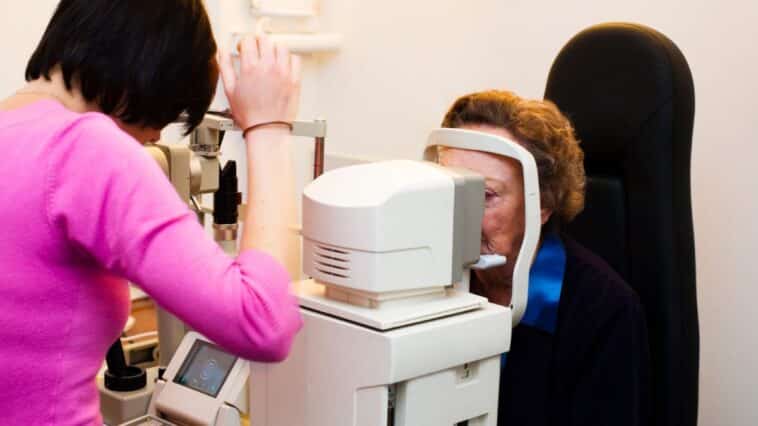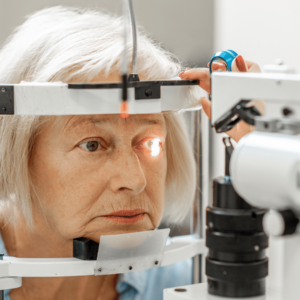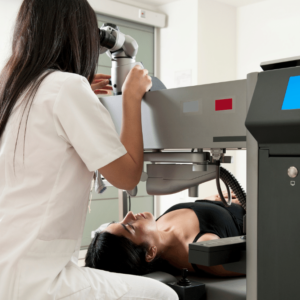Glaucoma vs. Cataracts: Definition
Glaucoma and cataracts are both eye conditions that can cause vision loss, but they differ in definition.
Glaucoma is a group of eye diseases that damage the optic nerve, which connects the eye to the brain. The damage to the optic nerve is often caused by increased pressure within the eye, which can result in gradual vision loss over time. Glaucoma can lead to permanent blindness if left untreated.
Cataracts, on the other hand, are a clouding of the lens in the eye. This clouding can occur due to aging, injury, or certain medical conditions. Cataracts can cause blurry or cloudy vision, making it difficult to see at night. Cataracts can also cause a sensitivity to light and halos around lights. Cataracts can be removed through surgery and are a common age-related condition.
Risk Factors for Glaucoma and Cataracts
There are several risk factors for developing glaucoma and cataracts, which include:
Risk Factors for Glaucoma:
- Age: Glaucoma is more common in people over the age of 60.
- Family history: If you have family members who suffer from this eye condition, there is a chance that you may be at higher risk for developing glaucoma as well.
- Ethnicity: African Americans, Hispanics/Latinos, and Asians are at a higher risk of developing glaucoma.
- Medical conditions: Diabetes, heart disease, high blood pressure, and sickle cell anemia can increase your risk of developing glaucoma.
- Eye health: People with a history of eye injuries, surgeries, or particular eye conditions, such as nearsightedness, are at a higher risk of developing glaucoma.
Risk Factors for Cataracts:
- Age: Cataracts are more common in older adults.
- Family history: A family history of cataracts can increase your chances of developing them. Those with a close relative with the eye condition should be extra cautious in monitoring their vision and checking for symptoms regularly.
- Medical conditions: Diabetes, high blood pressure, and obesity can increase your risk of developing cataracts.
- Lifestyle factors: If you smoke, drink large amounts of alcohol, and stay in the sun for extended periods, your risk of developing cataracts increases significantly.
- Previous eye injuries or surgeries: People with a history of eye injuries or surgeries may be at a higher risk of developing cataracts.
Glaucoma vs. Cataracts: Signs and Symptoms
Signs and symptoms of glaucoma and cataracts can differ, so here are the common ones for each condition:
Signs and Symptoms of Glaucoma:
- Loss of peripheral vision: In the early stages of glaucoma, peripheral vision loss may be the only symptom.
- Tunnel vision: As the disease progresses, vision loss may become more severe, leading to tunnel vision.
- Blurred vision: One of the symptoms of glaucoma is blurred vision, particularly in the advanced stages of the illness. This can cause images to appear hazy or out of focus, making it difficult to see clearly.
- Halos around lights: Some people with glaucoma may experience halos around lights, especially at night.
- Eye pain: Acute angle-closure glaucoma can cause sudden eye pain, headache, and nausea.
Most people with glaucoma have no symptoms in the early stages of the disease. Regular eye exams with an eye doctor are crucial for early detection and treatment.
Signs and Symptoms of Cataracts:
- Blurry or cloudy vision: The most common symptom of cataracts is blurry or cloudy vision.
- Difficulty seeing at night: Cataracts can cause difficulty seeing in low light conditions, such as at night.
- Sensitivity to light and glare: Some people with cataracts may be more sensitive to light and glare than others.
- Faded colors: Colors may appear faded or yellowed with cataracts.
- Double vision in one eye: In some cases, cataracts can cause double vision in one eye.
Cataracts can develop slowly, and some people may not notice any symptoms in the early stages.
Diagnosis and Treatment Options
Diagnosis and treatment options for glaucoma and cataracts are different.
Diagnosis of Glaucoma:
- A comprehensive eye exam includes measuring intraocular pressure, examining the optic nerve, and testing visual fields.
- Optical coherence tomography (OCT): This is a non-invasive imaging test that allows the doctor to see the structure of the optic nerve.
- Gonioscopy: This procedure examines the angle where the iris meets the cornea to determine if it is open or closed.
- Treatment options for glaucoma:
- Eye drops: These can help lower eye pressure.
- Oral medications: These can also help lower eye pressure.
- Laser trabeculoplasty: This procedure uses a laser to improve fluid flow out of the eye, lowering eye pressure.
- Conventional surgery: This procedure creates a new drainage channel for the fluid to flow out of the eye, lowering eye pressure.
Diagnosis of Cataracts:
- A comprehensive eye exam includes testing visual acuity, measuring eye pressure, and examining the lens.
- Treatment options for cataracts:
- Eyeglasses or contact lenses can improve vision in the early stages of cataracts.
- Surgery involves removing and replacing the cloudy lens with an artificial one. This is the only effective treatment for advanced cataracts.
Cataracts and glaucoma are two eye conditions that can lead to vision loss if left untreated. Fortunately, both can be effectively managed when detected early through regular eye exams. To maintain optimal eye health and reduce the risk of vision loss, scheduling routine eye exams with an optometrist or ophthalmologist is crucial.
Prevention Tips for Glaucoma and Cataracts
Several prevention tips can help reduce the risk of developing glaucoma and cataracts:
Prevention Tips for Glaucoma:
- Protect your eyes: Wear protective eyewear when participating in sports or activities that may cause eye injury.
- Regular eye exams: Early detection and treatment of glaucoma can help prevent vision loss.
- Exercise regularly: Regular exercise can help lower eye pressure and improve overall health.
- Maintain a healthy weight: Being overweight or obese can increase the risk of developing glaucoma.
Prevention Tips for Cataracts:
- Wear sunglasses: Protecting your eyes from UV rays with sunglasses can help reduce the risk of developing cataracts.
- Quit smoking: Quitting smoking could help to reduce your risk of developing this condition.
- Eat a healthy diet: Eating a balanced and nutritious diet full of fruits and vegetables may help to reduce the chances of developing cataracts. Filling your plate with produce packed with antioxidants can protect your eyes from age-related vision issues such as cataracts.
- Manage medical conditions: Being aware of certain medical conditions like diabetes and high blood pressure can be vital in preventing the development of cataracts. Keeping these conditions under control is critical to reducing the risk of developing cataracts.
Glaucoma and cataracts are severe eye diseases that can cause vision problems. Fortunately, one can take a few preventive measures to reduce the risk of developing them. Essential steps to preserving good eye health include regular check-ups with an eye doctor. Taking these crucial precautions can help protect your vision for the future.
Lifestyle Changes to Reduce the Risk of Both Diseases
There are several lifestyle changes you can make to reduce the risk of both glaucoma and cataracts:
- Get regular eye exams: Regular eye exams can help detect early signs of glaucoma and cataracts, allowing for early treatment and potentially preventing vision loss.
- Maintain a healthy diet: Eating a healthy diet with plenty of fruits and vegetables can provide the necessary vitamins and nutrients to support eye health.
- Exercise regularly: Regular exercise can help reduce the risk of both glaucoma and cataracts, as it can help lower eye pressure and improve overall health.
- Quit smoking: Smoking is a risk factor for both glaucoma and cataracts, so quitting smoking can help reduce the risk of developing these conditions.
- Wear protective eyewear: Wearing protective eyewear, such as safety glasses or goggles, can help prevent eye injury that could lead to glaucoma or cataracts.
- Manage medical conditions: Certain conditions, such as diabetes and high blood pressure, can increase the risk of developing glaucoma and cataracts. Managing these conditions can help reduce the risk.
- Protect your eyes from UV rays: If you want to reduce your risk of developing cataracts, take the necessary precautions to protect your eyes from harmful UV rays. This can be done by wearing sunglasses or a wide-brimmed hat when out in the sun’s rays.
By incorporating these lifestyle changes, you can reduce your risk of developing glaucoma and cataracts and maintain good eye health.






